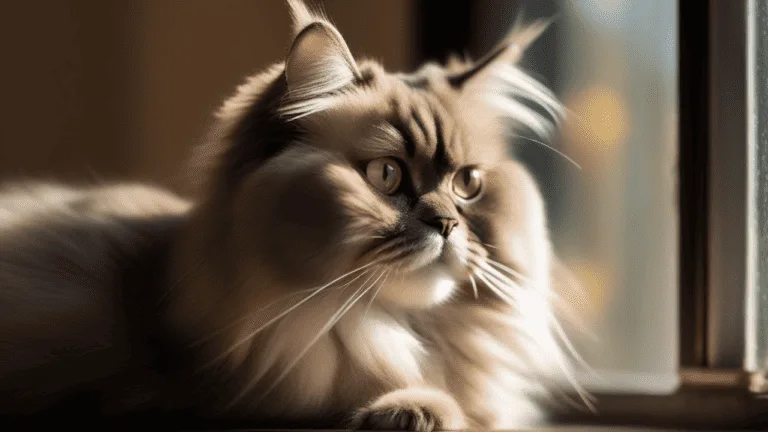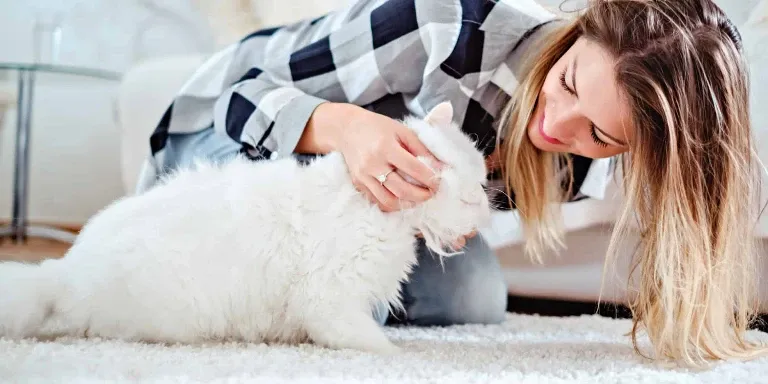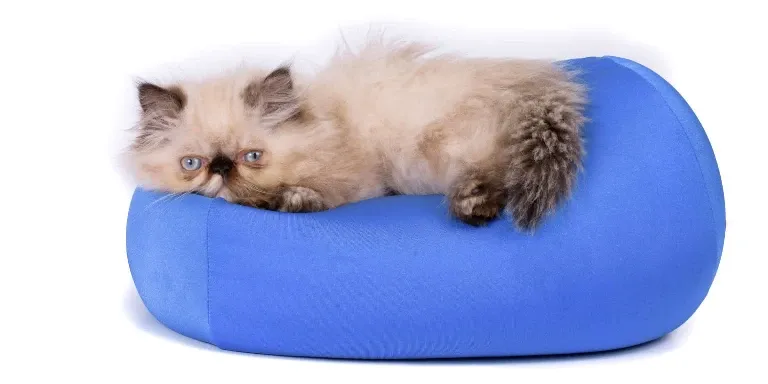The Best Fluffy Pancakes recipe you will fall in love with. Full of tips and tricks to help you make the best pancakes.

Do you have a Persian cat or are you considering getting one? One thing you may be wondering is whether or not Persian cats are clingy. Persian cats are known for their lux
Persian cats are known to be affectionate and enjoy being close to their owners, but whether or not they are clingy depends on the individual cat’s personality and upbringing. Some Persian cats may be more independent while others may be more prone to clinginess.urious coat and sweet disposition, but their level of clinginess can vary from cat to cat.
In this article, we will explore the characteristics of Persian cats, what makes them clingy, and how to deal with their clinginess. While some cats prefer to be left alone, others enjoy the company of their human family and can become quite clingy. Persian cats are no exception.
They are known for their affectionate nature and love to be around their humans. However, not all Persian cats are clingy, and it can depend on various factors such as their personality, environment, and upbringing. Understanding what makes Persian cats clingy and how to manage their clinginess can help you create a harmonious relationship with your feline friend.
Characteristics of Persian Cats
The Persian cat’s luxurious coat, flat face, and affectionate nature make it a popular breed for those seeking a loving and low-maintenance companion. Although their long and silky fur is stunning, grooming needs are a significant consideration for potential owners. Persian cats require daily brushing to prevent matting, particularly around their ears and underbelly. Neglecting their grooming needs can result in painful skin conditions and even infections.
In addition to grooming needs, health concerns are also a consideration for those interested in adopting a Persian cat. Due to their flattened faces, they’re prone to respiratory issues and eye infections. Regular visits to the veterinarian are essential to ensure their health and well-being.
Despite these potential health problems, Persian cats are generally low-energy and calm, making them suitable for apartment living. Overall, Persian cats make excellent companions for those seeking an affectionate and laid-back pet. However, their grooming needs and potential health concerns should be taken into consideration before bringing one home. With proper care and attention, a Persian cat can be a loyal and loving addition to any household.
Understanding Clinginess in Cats
You might notice that some felines have a strong desire to be close to their humans. This behavior is known as clinginess, and it’s not uncommon among domestic cats. However, it’s important to understand that clinginess doesn’t necessarily mean that your cat is needy or dependent. In fact, it’s possible for a cat to be both clingy and independent at the same time.
To help you better understand clinginess in cats, here are four things to keep in mind:
- Clinginess is a natural behavior for some cats. Some cats are just naturally more social and affectionate than others.
- Clinginess can be a sign of anxiety or stress. If your cat suddenly becomes more clingy than usual, it could be a sign that they’re feeling anxious or stressed about something. This could be due to a change in their environment, such as a move to a new home or the introduction of a new pet.
- Clinginess can be a sign of illness. If your cat is suddenly more clingy than usual, it’s important to take them to the vet to rule out any underlying health issues.
- Clinginess can be a sign of love. While clinginess can sometimes be a sign of anxiety or stress, it can also be a sign that your cat loves you and wants to be close to you. So, if your cat is always by your side, take it as a compliment!
Factors That Influence Clinginess in Persian Cats
When it comes to understanding clinginess in Persian cats, there are a few key factors to consider.
Age can play a role, as younger cats tend to be more energetic and curious, while older cats may become more attached to their owners.
Gender may also be a factor, with some male cats being more affectionate than females.
Additionally, the environment in which the cat lives can influence their level of clinginess, with cats in smaller spaces or with fewer opportunities for stimulation potentially becoming more dependent on their owners.
Age
If you’re considering getting a Persian cat, it’s important to note that age plays a significant role in their clinginess. As they age, Persian cats tend to become more affectionate and attached to their owners. This is due to the effects of aging, which can cause them to become more dependent on their human companions for comfort and security.
However, it’s important to note that aging can also bring about health concerns in Persian cats, which can affect their clinginess. For example, older cats may develop arthritis or other mobility issues, which can make them less likely to seek out attention and affection from their owners. Additionally, older cats may experience cognitive decline, which can cause them to become more anxious or confused, leading to increased clinginess and need for reassurance from their owners.
Overall, while age can play a significant role in a Persian cat’s clinginess, it’s important to consider their overall health and well-being when assessing their behavior.
Gender
Did you know that male Persian cats tend to have a higher risk of urinary tract infections compared to their female counterparts? In fact, one study showed that male cats were almost three times more likely to develop this condition. This is due to the fact that the male cat’s urethra is longer and narrower than the female’s, making it more prone to blockages and infections.
To prevent urinary tract infections in your male Persian cat, there are a few things you can do. Firstly, make sure your cat is drinking plenty of water to promote healthy urination. Secondly, consider a high-quality, grain-free diet to promote overall urinary tract health.
Thirdly, keep the litter box clean and encourage your cat to use it regularly. Lastly, consider training techniques such as positive reinforcement to encourage your cat to use the litter box consistently.
By taking these steps, you can help prevent urinary tract infections in your male Persian cat and ensure a happy, healthy feline companion.
Environment
Now that we’ve discussed gender and its potential impact on a Persian cat’s clinginess, let’s dive into the environment in which a Persian cat lives. This is an important factor to consider when determining whether a Persian cat is clingy or not.
Specifically, we’ll look at whether a cat is kept indoors or outdoors, and how the presence of other pets in the household may affect their clinginess.
Indoor Persian cats tend to be more dependent on their owners for attention and affection. Since they don’t have access to the outdoors, they rely solely on their human companions for stimulation, exercise, and entertainment. This can lead to them becoming more attached to their owners and exhibiting clingy behavior.
Conversely, outdoor Persian cats have more opportunities to explore and engage with their surroundings, which can make them less dependent on their owners for entertainment and attention.
As for the presence of other pets, it can have a significant impact on a Persian cat’s clinginess. If a cat is the only pet in the household, it may become more reliant on its owner for companionship. However, if other pets are present, the cat may bond with them and become less clingy towards its owner.
Signs of Clinginess in Persian Cats
Moreover, Persian cats are known for their clingy behavior and can display signs of following their owners around the house. They crave constant attention and affection from their owners and can become distressed when they’re left alone for extended periods.
If you’re a busy person, managing clinginess in your Persian cat can be challenging, but with the right training techniques, it’s possible to reduce their clingy behavior. One way to train your Persian cat to be less clingy is to create a routine that includes spending time with them every day. This could be as simple as playing with them or cuddling with them for a few minutes each day.
You can also give them interactive toys to keep them entertained when you’re away from home. Positive reinforcement training techniques can also help to reduce clingy behavior in Persian cats, such as rewarding them with treats or praise for good behavior. It’s important to remember that Persian cats are naturally affectionate and love to be around their owners.
However, if their clingy behavior becomes excessive, it can be a sign of anxiety or stress. If you’re struggling to manage your Persian cat’s clinginess, it may be worth seeking advice from a veterinarian or animal behaviorist to identify the underlying cause of their behavior and develop a plan to address it.
Dealing with Clinginess in Persian Cats
To manage your furry friend’s neediness, spend quality time with them and give them interactive toys. This can be helpful in decreasing their constant demands for attention. Encourage your Persian cat to play with toys that stimulate their minds and bodies, which can help keep them occupied and entertained. This can also help your cat develop their independence, which can be beneficial in reducing clinginess.
Another way to address clinginess in Persian cats is through training for separation anxiety. Gradually increase the amount of time you spend away from your cat, until they become comfortable being alone for longer periods. You can also provide them with a safe and comfortable space, such as a cozy bed or a cat tree, where they can retreat when they need some alone time.
In addition to spending quality time with your cat and providing them with interactive toys, it’s important to establish a consistent routine. This can help your cat feel more secure and confident, which can in turn reduce their clinginess. By following these simple steps, you can help your Persian cat become more independent and less clingy, while still enjoying all the love and affection they have to offer.
Alternatives to Clinginess
If you’re struggling with a needy Persian cat, try implementing some training techniques to encourage independence and reduce their constant demands for attention. It’s important to remember that cats are creatures of habit, and their clinginess may be a result of not having enough mental stimulation.
Here are some alternatives to keep your Persian cat entertained and engaged:
- Puzzle feeders: These types of feeders require your cat to work for their food, providing mental stimulation and reducing boredom.
- Interactive toys: Toys that require your cat to play and engage with them can help keep them mentally stimulated and entertained.
- Vertical space: Providing your cat with vertical space, such as a cat tree or shelving, can give them a sense of ownership over their territory and provide a new perspective on their environment.
- Playtime: Regular playtime with your cat can help build a bond and provide them with the attention they crave, while also giving them physical and mental exercise.
- Positive reinforcement: Rewarding your cat for independent behavior, such as playing alone or finding their own entertainment, can encourage them to continue these behaviors.
By implementing these techniques, you can help reduce your Persian cat’s clinginess and encourage them to become more independent and mentally stimulated. Remember to be patient and consistent with your training, and always provide positive reinforcement for good behavior. With time and effort, your cat can learn to enjoy their own company and become a happier and more content feline companion.
Pros and Cons of Clinginess in Persian Cats
When it comes to Persian cats, their clinginess can be both a blessing and a curse.
On the one hand, their affectionate nature can provide comfort and companionship to their owners. However, on the other hand, their constant need for attention and physical contact can become overwhelming and even annoying at times.
It’s important to weigh the pros and cons of clinginess in Persian cats before deciding if it’s the right breed for you.
Benefits of Clinginess
Clingy Persian cats may demand a lot of attention, but their affectionate nature can provide comfort and companionship. Here are some benefits of having a clingy Persian cat as your pet:
- They’re great for emotional support. Persian cats are known for their soothing presence and can provide comfort during stressful times. Their clingy nature means they’ll always be by your side, offering a sense of security and comfort.
- They make great lap cats. If you’re looking for a furry friend to cuddle with on the couch, a clingy Persian cat is the perfect choice. They love nothing more than snuggling up with their humans and will happily spend hours on your lap.
- They can help with loneliness. If you live alone or spend a lot of time by yourself, a clingy Persian cat can provide much-needed companionship. They thrive on human attention and will always be there to keep you company.
- They are loyal and devoted. Clingy Persian cats are fiercely loyal to their owners and will always be there to protect and comfort them. They form strong bonds with their humans and will do whatever it takes to make them happy.
While dealing with a clingy pet can be challenging at times, the benefits of having a Persian cat that craves your attention and affection make it all worthwhile. With their emotional support, cuddly nature, and unwavering loyalty, a clingy Persian cat can be the perfect addition to your family.
Drawbacks of Clinginess
Unfortunately, having a clingy Persian cat can lead to some drawbacks for owners. While it’s understandable to want your pet to love and be close to you, constant clinginess can lead to a lack of personal space and privacy. This can become especially overwhelming if you have a busy lifestyle or prefer alone time.
The effects of a clingy Persian cat can also extend beyond just lack of personal space. They may become overly attached and anxious when you’re not around, which can lead to destructive behavior or even separation anxiety. However, there are ways to manage clingy behavior in Persian cats. For instance, you can provide plenty of toys and activities to keep them occupied, establish a consistent routine, and gradually increase the amount of alone time they have. With patience and consistency, you can help your Persian cat feel more independent and less reliant on constant attention from you.
Do Persian and Himalayan Cats Share Similar Clingy Behaviors?
Yes, Persian and Himalayan cats share similar clingy behaviors. Himalayan cats exhibit affectionate and clingy traits, just like Persian cats. Both breeds are known for their desire to be close to their owners and to seek out attention and affection. This common behavior trait makes them beloved pets for many.
Conclusion
In conclusion, if you’re looking for a cat that will be your constant companion and shower you with affection, then a Persian cat might just be the perfect fit for you.
With their fluffy coats, adorable faces, and loving personalities, these cats are sure to steal your heart. However, it’s important to remember that while Persian cats may be clingy, they also require a lot of attention and care.
But don’t let that discourage you! The benefits of having a Persian cat as a loyal companion far outweigh the challenges. Whether you’re looking for a cuddle buddy or a furry friend to keep you company, a Persian cat is sure to provide you with endless love and affection.
So go ahead, bring home a Persian cat today and experience the joy of having a truly devoted feline friend!








